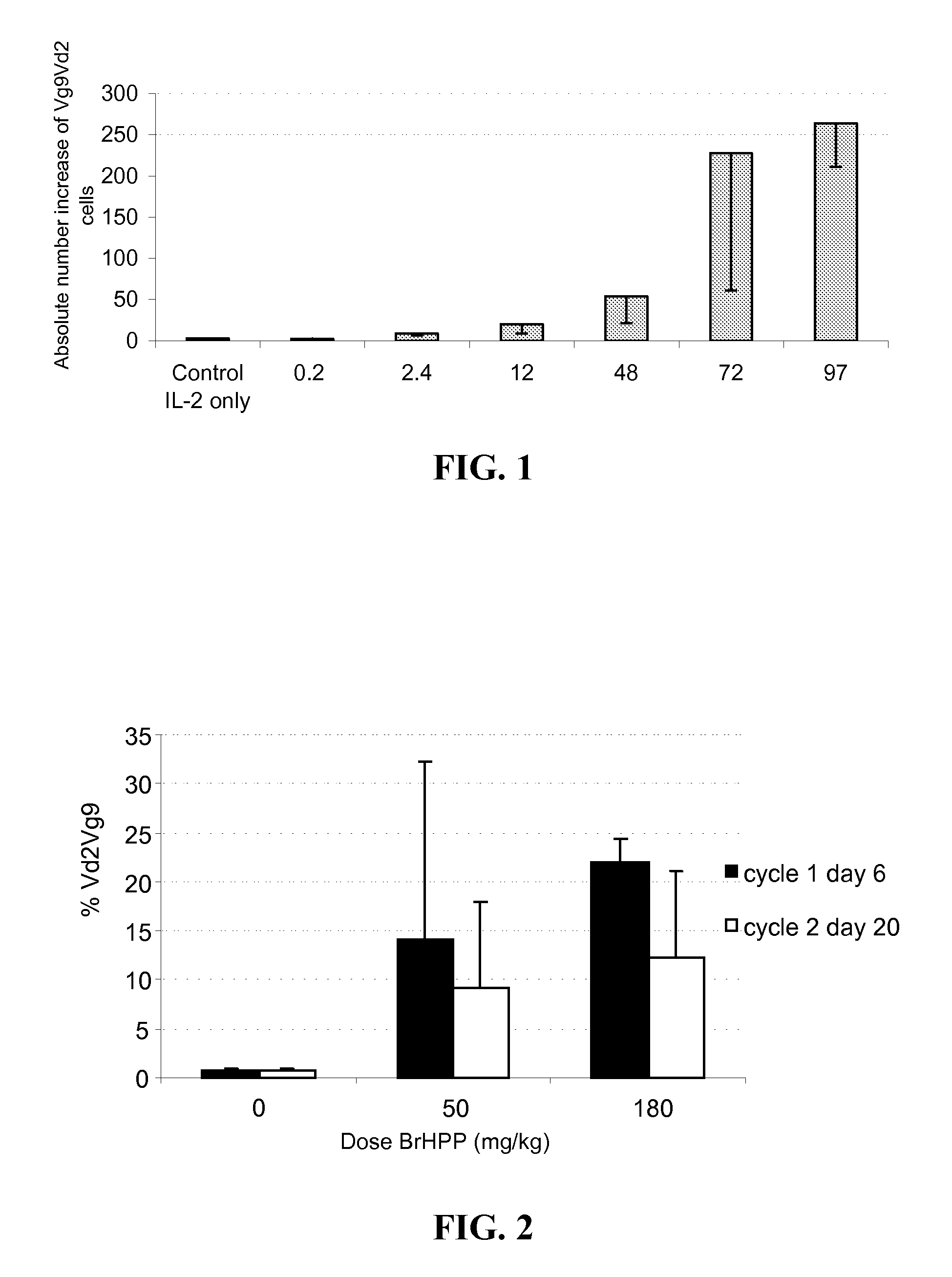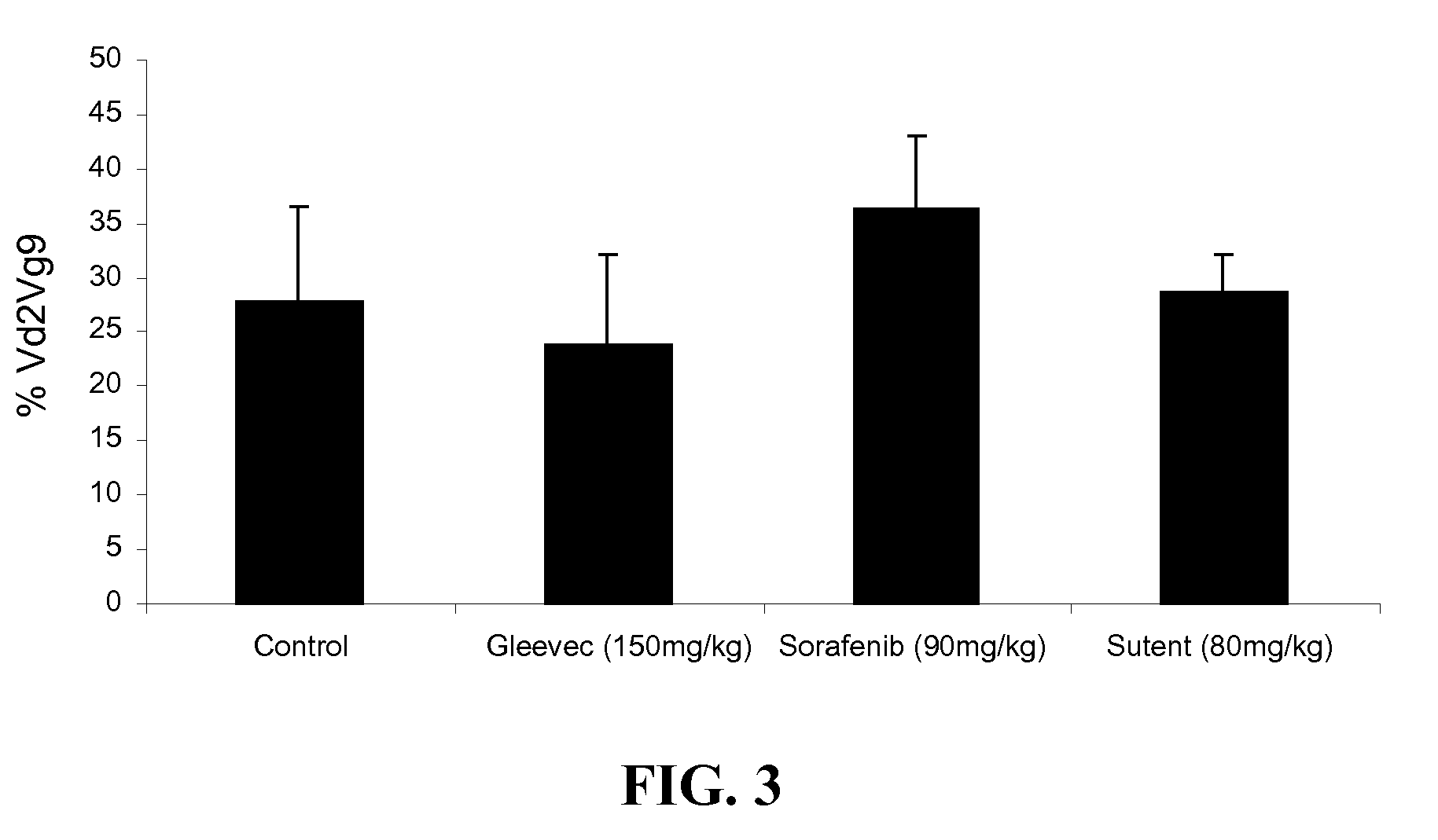Methods of Using Phosphoantigen for the Treatment of Cancer
a cancer and phosphoantigen technology, applied in the field of antiangiogenic chemotherapeutic agents, can solve the problems of tumors that may “escape” and become yet more resistant to other therapies, and the treatment of cancer is not effective for all patients
- Summary
- Abstract
- Description
- Claims
- Application Information
AI Technical Summary
Benefits of technology
Problems solved by technology
Method used
Image
Examples
example 1
Flow Cytometry Detection of T Cell Amplification
[0379]Blood samples (4 ml) were withdrawn into EDTA containing tubes. Tubes were shipped overnight at room temperature (RT) before flow cytometry analyses.
[0380]Peripheral lymphocytes were analyzed by flow cytometry on total blood, after triple staining with anti-Vdelta2FITC, anti-CD3PE and anti-CD25PC5 antibodies (Vdelta2-FITC : IMMU389 clone, Immunotech-Beckman-Coulter, Marseilles, France; CD3-PE : UCHTI clone, Immunotech-Beckman-Coulter; CD25PC5 : M-A251 clone, Becton Dickinson, Le Pont de Claix, France).
[0381]Briefly, 100 μl patient blood was incubated 15 min at RT with 10 μl anti-Vdelta2-FITC, 10 μl anti-CD3-PE and 10 μl anti-CD25PC5 antibodies. Antibodies were washed with 3 ml 1× PBS, centrifuged for 4 min at 1300 rpm at RT and supernatant was discarded. Red cells were lysed with the OptiLyse B reagent (Immunotech-Beckman-Coulter, Marseilles, France) according to the manufacturer's instructions. At the final step, stained white b...
example 2
Phosphostim-Induced Amplification of γδ T Cells in Chemotherapy-Treated Patients
[0382]PHOSPHOST™ (Bromohydrin pyrophosphate, BrHPP) was evaluated in an escalating dose clinical trial in patients with advanced / metastatic solid tumors. The therapeutic regimen and pharmaco-toxicology of BrHPP in combination with low dose of IL-2 have previously been characterized in non human primates. The patients received at least 3 injections of BrHPP 3 weeks apart, concomitant with low dose of IL-2 (1 million IU / m2 / day). Pharmacological response was monitored all along the treatment. Based on the results of the phase I trial, a multicenter phase II study on metastatic RCC patients has been scheduled. The clinical drug product was a 200 mg / vial of lyophilized Phosphostim (expressed in mg equivalent of BrHPP anionic form.). The formulation of Phosphostim was reconstituted immediately prior to use with 2 ml of water for injections to make a 100 mg / ml solution. The reconstituted product was diluted in ...
example 3
Phosphostim-Induced Amplification of γδ T Cells from Patients Undergoing Gleevec Therapy
[0402]The study intends to test the sensitivity of γ962 T cells from oncology patients to BrHPP. It aims at identifying cancers and or situations in which a BrHPP treatment would be relevant and those for which it would be less or not beneficial. In brief, a small sample of blood is sufficient to prepare PBMCs and culture in the presence of BrHPP. A result of the level of in vitro amplification of gamma-delta cells by BrHPP can be obtained in about 8 days.
[0403]Blood was collected from 19 patients having CML (chronic myelogenous leukemia) and undergoing treatment with imitanib mesylate (STI571, Glivec™, Gleevec™, Novartis). Upon reception of blood, 20 ml blood samples were treated by Ficoll gradient to isolate peripheral lymphocytes, which were then frozen. The lymphocytes were cultured in a 96-well plate (1 million cells / ml) for 8 days in the presence of BrHPP. The percentage of γ962 T cells wer...
PUM
| Property | Measurement | Unit |
|---|---|---|
| pH | aaaaa | aaaaa |
| pharmaceutical composition | aaaaa | aaaaa |
| compositions | aaaaa | aaaaa |
Abstract
Description
Claims
Application Information
 Login to View More
Login to View More - R&D
- Intellectual Property
- Life Sciences
- Materials
- Tech Scout
- Unparalleled Data Quality
- Higher Quality Content
- 60% Fewer Hallucinations
Browse by: Latest US Patents, China's latest patents, Technical Efficacy Thesaurus, Application Domain, Technology Topic, Popular Technical Reports.
© 2025 PatSnap. All rights reserved.Legal|Privacy policy|Modern Slavery Act Transparency Statement|Sitemap|About US| Contact US: help@patsnap.com



